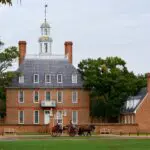The American Civil War gave rise to many celebrated figures whose names are now firmly etched in history—Grant, Sherman, and Sheridan are often the most recognized among them. However, behind these iconic leaders were other commanders who played crucial roles in ensuring Union victories.
While often overlooked, the contributions of these other commanders were crucial in shaping the war’s outcome during several key moments. This blog highlights five Union generals whose significant accomplishments deserve more recognition, ranging from their steadfast leadership at Gettysburg to their pivotal victories in lesser-known theaters of battle.
If you are traveling in Virginia, please consider joining us for a historian-led Visit to the Battlefields of Virginia.

George Meade
George Gordon Meade is often overshadowed by the more prominent figure of Ulysses S. Grant, but his leadership during the Battle of Gettysburg must be recognized as one of the most critical turning points of the Civil War. Appointed as commander of the Army of the Potomac just days before the battle, Meade took charge of a demoralized army facing a determined Confederate invasion. His quick organizational skills and strategic deployment were essential in repelling General Lee’s forces during those decisive three days in July 1863.
Despite his success, Meade received limited recognition, as much of the credit for the Union’s broader victories was given to Grant, who was promoted shortly thereafter. Meade’s reserved and practical leadership style did not lend itself to self-promotion, but his steady hand during the chaotic aftermath of Gettysburg was crucial.
Nathan Kimball
Nathan Kimball was a brigadier general in the Union Army who was recognized for his tactical brilliance and reliable leadership during several lesser-known yet significant battles of the Civil War. His first major triumph came at the Battle of Cheat Mountain in September 1861, where he effectively thwarted a Confederate offensive led by Robert E. Lee. Kimball’s skill in coordinating his troops amid the challenging, rugged terrain not only solidified the Union’s position in western Virginia but also dealt an early blow to Lee’s growing reputation.
Kimball’s leadership prowess didn’t stop at Cheat Mountain. In 1862, during the Shenandoah Valley Campaign, he played a vital role in the Battle of Kernstown, where his forces managed to defeat Confederate General Stonewall Jackson. This marked Jackson’s only tactical defeat throughout the war, delaying his advances and lifting Union morale in the area.

David M. Gregg
David McMurtrie Gregg was a Union cavalry officer renowned for his effective command, which was crucial for reconnaissance and protection of the Army of the Potomac. His actions during the Battle of Brandy Station in June 1863, the largest cavalry engagement of the Civil War, marked a significant shift in the effectiveness of Union cavalry. Gregg’s leadership was essential in countering the Confederate cavalry led by J.E.B. Stuart, demonstrating that Union forces could match their Southern counterparts in both mobility and combat skills.
Gregg’s contributions continued throughout the Gettysburg Campaign, particularly on the third day of the battle. While Pickett’s Charge received most of the attention, Gregg’s cavalry successfully engaged Stuart’s forces in a separate confrontation east of the main battlefield. By holding their ground and preventing Stuart from flanking the Union position, Gregg played a vital role in maintaining the integrity of General Meade’s defenses during this critical moment.
Gregg often remains overshadowed by more flamboyant figures like Philip Sheridan. However, his quiet competence and focus on coordination made him an essential part of the evolution of Union cavalry. Consider joining our team for a Tour of the Brandy Station Battlefield.
James B. Ricketts
James B. Ricketts began his Civil War service as an artillery officer, leading a battery during the First Battle of Bull Run in 1861. His unit faced relentless assaults from Confederate forces, and he was severely wounded and taken prisoner. After being released in a prisoner exchange, Ricketts returned to active duty, transitioning to infantry command, where he consistently exhibited strong leadership in the heat of battle.
A pivotal moment in Ricketts’ career came during the Second Battle of Bull Run in 1862. As he led a division in General John Pope’s Army of Virginia, Ricketts played a crucial role in holding the Union line against relentless Confederate attacks. His disciplined leadership bought precious time, preventing a complete breakdown of Union forces during the tumultuous retreat.
Ricketts also took part in the Overland Campaign of 1864, where his division faced some of the war’s harshest battles, including the Battle of Spotsylvania Court House. Despite suffering multiple wounds throughout the conflict, he remained steadfast in his command, showcasing the resilience and dedication characteristic of Union leadership.
Take your expiration of Civil War history to another level with a visit to the Spotsylvania Court House Battlefield.

Frederick Steele
Frederick Steele played a crucial role in the Western Theater, significantly contributing to the Union’s control over Arkansas and undermining Confederate resistance in the Trans-Mississippi region. In 1863, he led Union forces to a successful capture of Little Rock, the state capital. This operation resulted in minimal casualties and effectively disrupted Confederate governance in Arkansas, establishing a vital foothold for the Union west of the Mississippi River.
Following the capture, Steele focused on stabilizing Arkansas politically by backing efforts to establish a Unionist government and counteract guerrilla activity. His military campaigns showcased a keen understanding of the war’s larger objectives, blending military and political strategies to weaken Confederate authority.
In 1864, Steele spearheaded the Camden Expedition, an ambitious mission aimed at disrupting Confederate supply lines and bolstering Union operations in Louisiana. Although faced with logistical challenges and significant Confederate resistance that ultimately led to a withdrawal, Steele’s adeptness in conducting a fighting retreat allowed him to preserve a large portion of his forces.
This brings an end to our list of five underrated Union generals. If you are visiting Virginia, we hope you consider joining us on a Guided Visit to the American Civil War Battlefields of Virginia.


